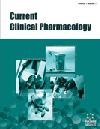- Home
- A-Z Publications
- Current Clinical Pharmacology
- Previous Issues
- Volume 2, Issue 3, 2007
Current Clinical Pharmacology - Volume 2, Issue 3, 2007
Volume 2, Issue 3, 2007
-
-
Modulation of Fatty Acids Oxidation in Heart Failure by Selective Pharmacological Inhibition of 3-Ketoacyl Coenzyme-A Thiolase
More LessAuthors: Gabriele Fragasso, Roberto Spoladore, Amarild Cuko and Altin PalloshiA direct approach to manipulate cardiac energy metabolism consists in modifying substrate utilization by the heart. Pharmacological agents that directly inhibit fatty acid oxidation include inhibitors of 3-ketoacyl coenzyme A thiolase (3-KAT), the last enzyme involved in β-oxidation. The most extensively investigated agents of this group of drugs are trimetazidine and ranolazine. Clinical studies have shown that these agents ca Read More
-
-
-
Chemotherapy and Delivery in the Treatment of Primary Brain Tumors
More LessAuthors: David Mathieu and David FortinMalignant astrocytomas are aggressive neoplasms with a dismal prognosis despite optimal treatment. Maximal resective surgery is traditionally complemented by radiation therapy. Chemotherapy is typically used on patients with tumor recurrence, when their functional status is congruent with further treatment. The classic agents used are nitrosoureas, but temozolomide is gradually taking a more prominent role recently. Read More
-
-
-
The Rabbit Syndrome: State of the Art
More LessIntroduction: The rabbit syndrome (RS) is a rare movement disorder generally associated with prolonged use of antipsychotics and characterized by inwilling, rhythmic, fast and fine movements of oral and masticatory muscles along the vertical axis of the mouth. Prevalence: The prevalence of RS ranges between 1.5% and 4.4%; middle and elderly ages, the female gender, aswell as past brain injuries are considered risk factors Read More
-
-
-
Applications of Artificial Neural Networks in Medical Science
More LessAuthors: Jigneshkumar L. Patel and Ramesh K. GoyalComputer technology has been advanced tremendously and the interest has been increased for the potential use of ‘Artificial Intelligence (AI)’ in medicine and biological research. One of the most interesting and extensively studied branches of AI is the ‘Artificial Neural Networks (ANNs)’. Basically, ANNs are the mathematical algorithms, generated by computers. ANNs learn from standard data and capture the knowledge Read More
-
-
-
Drugs Treatment of Pain in Multiple Sclerosis
More LessAuthors: Antonio Siniscalchi, Luca Gallelli and Giovambattista De SarroPain is a frequent and disabling symptom among multiple sclerosis (MS) and it is estimated to occur in 55% to 65% of patients. The mechanism of pain in MS has not yet been defined, because it can result from somatic, visceral, emotional, or neurologic impairment. The importance of this classification is related to different medical approaches to treat the pain in MS patients. In the management of symptomatic pain, new t Read More
-
-
-
The Pharmacokinetics and Pharmacodynamics of Levodopa in the Treatment of Parkinson's Disease
More LessAuthors: Soo-Peang Khor and Ann HsuLevodopa , a prodrug of dopamine, remains to be one of the main drugs in the treatment of Parkinson's disease. All current levodopa products are formulated with aromatic amino acid decarboxylase inhibitors such as carbidopa or benserazide to prevent the metabolism of levodopa in the gastrointestinal tract and systemic circulation. Levodopa pharmacokinetic profiles remain unchanged after multiple doses, and are simil Read More
-
-
-
A Review of the Immunosuppressive Activity of Cyclosporine Metabolites:New Insights into an Old Issue
More LessAuthors: Aygen Ozbay, Nikolaos Karamperis and Kaj Anker JorgensenCyclosporine A (CsA) is metabolized into a vast spectrum of metabolites. The potential immunosuppressive action of CsA's metabolites has been studied extensively in the early 1990's, with conflicting and inconclusive results. Since then, the pharmacological and clinical consensus guidelines recommend the use of specific monoclonal assays for measurement of CsA's concentrations thus avoiding metabolite interference. Nev Read More
-
-
-
Old and New Antiepileptic Drugs for the Treatment of Idiopathic Generalized Epilepsies
More LessAuthors: Alberto Verrotti, Rita Greco, Raffaella Giannuzzi, Francesco Chiarelli and Giuseppe LatiniGeneralized epilepsies are a large group of epilepsies with different clinical aspects and prognosis. Many antiepileptic drugs are available for the treatment of these seizures. This paper reviews the evidence relating to the treatment of this group of epilepsies. Historically, the great majority of patients have been treated with “old” anticonvulsant drugs. Over recent years, there has been a marked improvement in the pharmacol Read More
-
Volumes & issues
Most Read This Month
Article
content/journals/ccp
Journal
10
5
false
en


